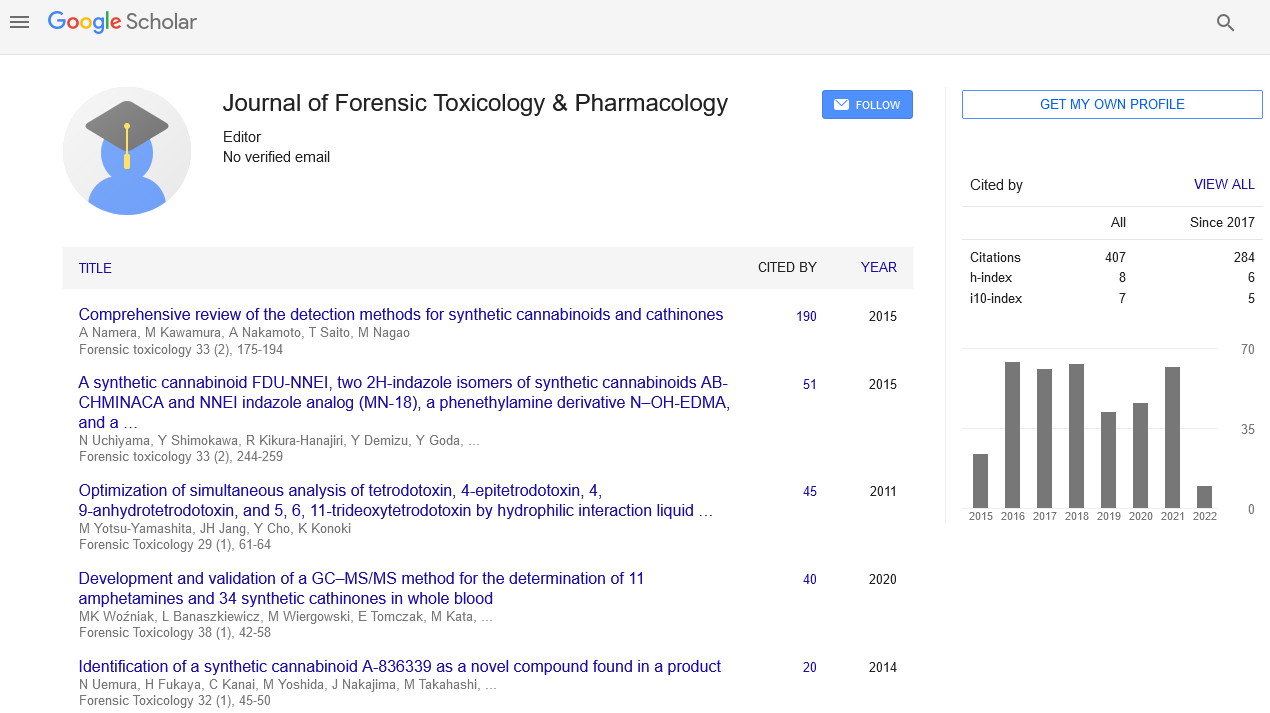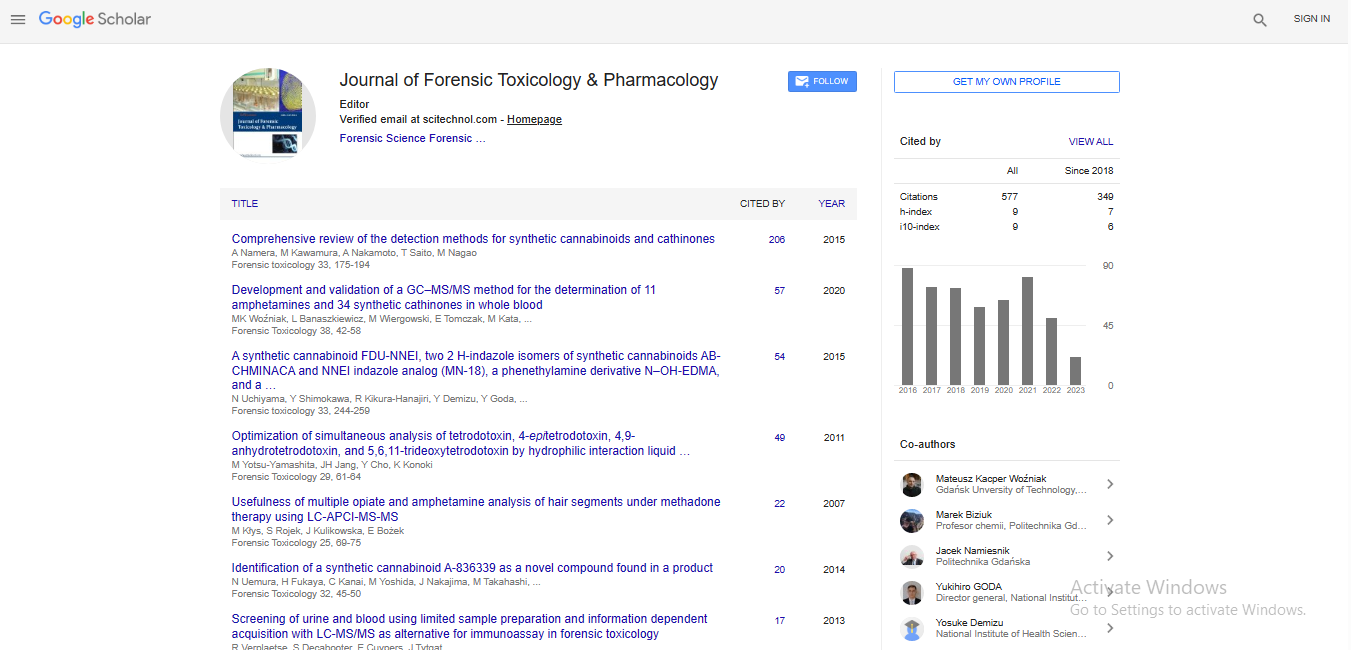Perspective, J Forensic Toxicol Pharmacol Vol: 13 Issue: 4
Evolving Technologies in Drug Testing and Monitoring
Magny Jouve*
1Department of Clinical Pharmacology, Hospital Universitario La Paz, Madrid, Spain
*Corresponding Author: Magny Jouve,
Department of Clinical Pharmacology,
Hospital Universitario La Paz, Madrid, Spain
E-mail: shueymonticello@gmail.com
Received date: 26 November, 2024, Manuscript No. JFTP-24-156272;
Editor assigned date: 28 November, 2024, PreQC No. JFTP-24-156272 (PQ);
Reviewed date: 12 December, 2024, QC No JFTP-24-156272
Revised date: 19 December, 2024, Manuscript No. JFTP-24-156272 (R);
Published date: 26 December, 2024, DOI: 10.4172/JFTP.1000206.
Citation: Jouve M (2024) Evolving Technologies in Drug Testing and Monitoring. J Forensic Toxicol Pharmacol 13:4.
Description
The landscape of drug testing and monitoring has undergone significant transformation, driven by advancements in analytical methods, digital technologies and societal demands for greater accuracy and reliability. These evolving technologies have broadened the scope of drug testing, improving its applications in clinical, forensic and occupational settings while addressing emerging challenges such as the detection of Novel Psychoactive Substances (NPS) and performance-enhancing drugs.
One of the most notable advancements in drug testing is the integration of Mass Spectrometry (MS) with chromatography techniques such as Gas Chromatography (GC) and Liquid Chromatography (LC). These hybrid techniques, including GC-MS and LC-MS, offer high sensitivity and specificity, enabling the detection of drugs and their metabolites at trace levels. The ability to identify a wide range of substances, including opioids, cannabinoids and amphetamines, has made these methods invaluable in both routine screenings and complex forensic investigations.
The emergence of High-Resolution Mass Spectrometry (HRMS) has further enhanced drug testing capabilities. HRMS provides unparalleled accuracy in identifying unknown compounds, making it particularly useful for detecting NPS and other substances that may not be included in standard testing panels. This technology is complemented by the development of comprehensive spectral libraries, which facilitate the rapid and accurate identification of compounds based on their unique mass-to-charge ratios.
In addition to advances in analytical techniques, digital innovations have revolutionized drug monitoring. The adoption of Laboratory Information Management Systems (LIMS) has streamlined workflows, improving the efficiency and accuracy of data management in drug testing laboratories. These systems enable the seamless integration of analytical instruments, automated data analysis and secure storage of test results, ensuring compliance with regulatory standards and facilitating timely reporting.
Point-Of-Care Testing (POCT) devices have also gained prominence in drug monitoring, offering rapid and reliable results outside traditional laboratory settings. These portable devices utilize immunoassay-based methods to detect drugs and their metabolites in biological samples such as saliva, urine and blood. POCT devices are particularly valuable in emergency situations, roadside drug testing and workplace screenings, where immediate results are difficult for decision-making.
The field of drug testing has also witnessed the incorporation of bioinformatics and machine learning techniques. These tools enhance the interpretation of complex datasets, identifying patterns and trends that may indicate drug use or abuse. Machine learning algorithms can predict drug metabolism and interactions, providing valuable insights for personalized medicine and Therapeutic Drug Monitoring (TDM).
Despite these advancements, the field of drug testing faces ongoing challenges. The rapid proliferation of NPS and designer drugs requires constant updates to testing methodologies and analytical instruments. Ensuring the accuracy and reliability of test results in diverse biological matrices, such as hair and sweat, remains a technical hurdle. Furthermore, ethical considerations surrounding privacy and consent in drug testing highlight the need for transparent and equitable practices.
The future of drug testing and monitoring is likely to be shaped by the continued integration of advanced technologies and interdisciplinary approaches. Miniaturized analytical devices, such as microfluidic chips and lab-on-a-chip systems, promise to bring laboratory-grade testing capabilities to portable formats. The adoption of blockchain technology for secure data management and sharing may address concerns about the confidentiality and integrity of test results. Evolving technologies in drug testing and monitoring have transformed the field, enhancing its accuracy, efficiency and applicability across various domains. By embracing innovations in analytical techniques, digital tools and ethical practices, the field is well-positioned to address emerging challenges and contribute to public health, safety and justice. These advancements support the dynamic nature of drug testing and its difficult role in a rapidly changing world.
 Spanish
Spanish  Chinese
Chinese  Russian
Russian  German
German  French
French  Japanese
Japanese  Portuguese
Portuguese  Hindi
Hindi 
